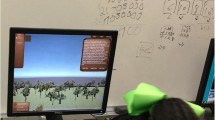Abstract
This mixed-method study aims to explore the feasibility of using the game-based, multimodal representation of mathematical problems to support middle school students’ practice and performance of math problem representation and solving. A three-dimensional architectural simulation game, called E-Rebuild, was developed to engage students in architecture-themed math problem solving and learning. Based on the data collected from 56 middle graders, the study findings suggested that interacting with game-based multimodal math problems helped students develop a systematic perspective and an analytical demeanor in coordinating external problem representations distributed across game objects and actions. Game-based problem solving promoted participants’ mathematical test performance as well as mental rotation task performance.




Similar content being viewed by others
Notes
All participants’ names cited in this paper are pseudonyms.
Two participants missed the pretest and their data were not included in the paired-sample t tests.
References
Shute, V. J., Ventura, M., & Ke, F. (2015). The power of play: The effects of Portal 2 and Lumosity on cognitive and noncognitive skills. Computers & Education, 80, 58–67.
Ke, F. (2016). Designing and integrating purposeful learning in game play: A systematic review. Educational Technology Research and Development, 64(2), 219–244.
Ainsworth, S. (1999). The functions of multiple representations. Computers & Education, 33(2–3), 131–152.
Anderson, J. R., Reder, L. M., & Simon, H. A. (1996). Situated learning and education. Educational Researcher, 25(4), 5–11.
Barab, S., Thomas, M., Dodge, T., Carteaux, R., & Tuzun, H. (2005). Making learning fun: Quest Atlantis, a game without guns. Educational Technology Research and Development, 53(1), 86–108.
Blum, W., & Niss, M. (1991). Applied mathematical problem solving, modelling, applications, and links to other subjects—State, trends and issues in mathematics instruction. Educational Studies in Mathematics, 22(1), 37–68.
Cheung, A. C., & Slavin, R. E. (2013). The effectiveness of educational technology applications for enhancing mathematics achievement in K-12 classrooms: A meta-analysis. Educational Research Review, 9, 88–113.
Clark, A. (2008). Supersizing the mind: Embodiment, action, and cognitive extension. New York, NY: Oxford University Press.
Clark, D. B., Nelson, B., Chang, H., D’Angelo, C. M., Slack, K., & Martinez-Garza, M. (2011). Exploring Newtonian mechanics in a conceptually-integrated digital game: Comparison of learning and affective outcomes for students in Taiwan and the United States. Computers and Education, 57(3), 2178–2195.
Clark, V., & Creswell, J. (2008). The mixed methods reader. Los Angeles, CA: SAGE.
Daroczy, G., Wolska, M., Meurers, W. D., & Nuerk, H. C. (2015). Word problems: A review of linguistic and numerical factors contributing to their difficulty. Frontiers in Psychology, 6(348), 1–13.
Dewolf, T., Van Dooren, W., Cimen, E. E., & Verschaffel, L. (2014). The impact of illustrations and warnings on solving mathematical word problems realistically. The Journal of Experimental Education, 82(1), 103–120.
Duval, R. (2006). A cognitive analysis of problems of comprehension in a learning of mathematics. Educational Studies in Mathematics, 61(1/2), 103–131.
Gagatsis, A., & Shiakalli, M. (2004). Ability to translate from one representation of the concept of function to another and mathematical problem solving. Educational Psychology, 24(5), 645–657.
Gee, J. P. (2003). What video games have to teach us about learning and literacy. New York, NY: Palgrave Macmillan.
Goldin, G. A. (2002). Representation in mathematical learning and problem solving. In L. D. English (Ed.), Handbook of international research in mathematics education (pp. 197–218). New York, NY: Routledge.
Große, E. (2014). Anthropogene Florenveränderungen in der Agrarlandschaft nördlich von Halle (Saale) [Anthropogenic Florenveränderungen in the agricultural landscape north of Halle (Saale)]. Hercynia-Ökologie und Umwelt in Mitteleuropa, 22(2), 129–172.
Harskamp, E. G., & Suhre, C. J. (2006). Improving mathematical problem solving: A computerized approach. Computers in Human Behavior, 22(5), 801–815.
Hegarty, M., & Kozhevnikov, M. (1999). Types of visual–spatial representations and mathematical problem solving. Journal of Educational Psychology, 91(4), 684–689.
Hegarty, M., Mayer, R. E., & Monk, C. A. (1995). Comprehension of arithmetic word problems: A comparison of successful and unsuccessful problem solvers. Journal of Educational Psychology, 87(1), 18–32.
Hoogland, K., Pepin, B., Bakker, A., de Koning, J., & Gravemeijer, K. (2016). Representing contextual mathematical problems in descriptive or depictive form: Design of an instrument and validation of its uses. Studies in Educational Evaluation, 50, 22–32.
Jonassen, D. H. (2000). Toward a design theory of problem solving. Educational Technology Research and Development, 48(4), 63–85.
Kilpatrick, J. (2014). History of research in mathematics education. In S. Lerman (Ed.), Encyclopedia of mathematics education (pp. 267–272). Dordrecht, Netherlands: Springer.
Kirsh, D. (2010). Thinking with external representations. AI & SOCIETY, 25(4), 441–454.
Koedinger, K. R., Alibali, M. W., & Nathan, M. J. (2008). Trade-offs between grounded and abstract representations: Evidence from algebra problem solving. Cognitive Science, 32(2), 366–397.
Koedinger, K. R., & Nathan, M. J. (2004). The real story behind context problems: Effects of representations on quantitative reasoning. The Journal of the Learning Sciences, 13(2), 129–164.
Koster, R. (2013). Theory of fun for game design. Sebastapol, CA: O’Reilly Media.
Kozhevnikov, M., Hegarty, M., & Mayer, R. E. (2002). Revising the visualizer-verbalizer dimension: Evidence for two types of visualizers. Cognition and Instruction, 20(1), 47–77.
Mayer, R. E. (1992). Thinking, problem solving, cognition (Second ed.). New York, NY: Freeman.
Mayer, R. E., & Wittrock, M. C. (1996). Problem-solving transfer. In D. C. Berliner & R. C. Calfee (Eds.), Handbook of educational psychology (pp. 47–62). New York, NY: Macmillan.
Mayer, R. E., & Wittrock, M. C. (2006). Problem solving. In P. A. Alexander & P. H. Winnie (Eds.), Handbook of educational psychology (pp. 287–303). Hillsdale, NJ: Lawrence Erlbaum.
Munez, D., Orrantia, J., & Rosales, J. (2013). The effect of external representations on compare word problems: Supporting mental model construction. The Journal of Experimental Education, 81(3), 337–355.
Nathan, M. J., Kintsch, W., & Young, E. (1992). A theory of algebra-word-problem comprehension and its implications for the design of learning environments. Cognition and Instruction, 9(4), 329–389.
Newell, A., & Simon, H. A. (1972). Human problem solving (Vol. 104, No. 9). Englewood Cliffs, NJ: Prentice-Hall.
Nistal, A. A., Van Dooren, W., Clarebout, G., Elen, J., & Verschaffel, L. (2009). Conceptualising, investigating and stimulating representational flexibility in mathematical problem solving and learning: A critical review. ZDM, 41(5), 627–636.
Núñez, R. E., Edwards, L. D., & Matos, J. F. (1999). Embodied cognition as grounding for situatedness and context in mathematics education. Educational Studies in Mathematics, 39(1–3), 45–65.
Patkin, D., & Gazit, A. (2011). Effect of difference in word formulation and mathematical characteristics of context problems on mathematics preservice teachers and practising teachers. International Journal of Mathematical Education in Science and Technology, 42(1), 75–87.
Presmeg, N. C. (1986). Visualisation in high school mathematics. For the learning of mathematics, 6(3), 42–46.
Robbins, P. E., & Aydede, M. E. (2009). The Cambridge handbook of situated cognition. Cambridge, UK: Cambridge University Press.
Sandoval, W. (2014). Conjecture mapping: An approach to systematic educational design research. Journal of the Learning Sciences, 23(1), 18–36.
Schoenfeld, A. H. (1992). Learning to think mathematically: Problem solving, metacognition, and sense making in mathematics. In D. Grouws (Ed.), Handbook of research on mathematics teaching and learning (pp. 334–370). New York, NY: Macmillan.
Shaffer, D. W. (2006). Epistemic frames for epistemic games. Computers & Education, 46(3), 223–234.
Shapiro, L. (2010). Embodied cognition. New York, NY: Routledge.
Squire, K. (2005). Game-based learning: Present and future state of the field. Masie Center e-Learning Consortium.
Tuminaro, J., & Redish, E. F. (2007). Elements of a cognitive model of physics problem solving: Epistemic games. Physical Review Special Topics - Physics Education Research, 3(2), 1–22.
Van den Heuvel-Panhuizen, M. (2003). The didactical use of models in realistic mathematics education: An example from a longitudinal trajectory on percentage. Educational Studies in Mathematics, 54(1), 9–35.
Van Eck, R., & Dempsey, J. (2002). The effect of competition and contextualized advisement on the transfer of mathematics skills a computer-based instructional simulation game. Educational Technology Research and Development, 50(3), 23–41.
Van Garderen, D. (2006). Spatial visualization, visual imagery, and mathematical problem solving of students with varying abilities. Journal of Learning Disabilities, 39(6), 496–506.
Van Garderen, D., & Montague, M. (2003). Visual-spatial representation, mathematical problem solving, and students of varying abilities. Learning Disabilities Research & Practice, 18(4), 246–254.
Verschaffel, L., Greer, B., & De Corte, E. (2000). Making sense of word problems. Lisse: Swets and Zeitlinger.
Walkington, C., Petrosino, A., & Sherman, M. (2013). Supporting algebraic reasoning through personalized story scenarios: How situational understanding mediates performance. Mathematical Thinking and Learning, 15(2), 89–120.
Walkington, C., Sherman, M., & Petrosino, A. (2012). “Playing the game” of context problems: Coordinating situation-based reasoning with algebraic representation. The Journal of Mathematical Behavior, 31(2), 174–195.
Wong, W. K., Hsu, S. C., Wu, S. H., Lee, C. W., & Hsu, W. L. (2007). LIM-G: Learner-initiating instruction model based on cognitive knowledge for geometry word problem comprehension. Computers & Education, 48(4), 582–601.
Xin, Y. P., & Zhang, D. (2009). Exploring a conceptual model-based approach to teaching situated word problems. The Journal of Educational Research, 102(6), 427–442.
Author information
Authors and Affiliations
Corresponding author
Appendix 1. An exemplary item in the math problem-solving test and an exemplary item in the mental rotation test
Appendix 1. An exemplary item in the math problem-solving test and an exemplary item in the mental rotation test
Some family friends have asked you to plan a rafting expedition. A rafting company has agreed to take your group down the Babbling River, and the rafting company has given you specific details on how much weight a raft can hold. A raft can safely carry the weight of 24 infants. It is known that the weight of 12 infants is exactly equal to the weight of 4 teenagers; the weight of 6 teenagers is exactly equal to the weight of 3 adults. Determine the least number of rafts that is needed for a trip with 11 adults, 5 teenagers, and 21 infants. (Note that supervision of the infants is not necessary.)
The left figure is the model. Among the three figures to the right of the model, please choose the figure which is identical to the original figure, aside from its orientation. Please circle the correct answer. To figure out which one does, you will have to rotate the figures around in your head.

Rights and permissions
About this article
Cite this article
Ke, F., M. Clark, K. Game-Based Multimodal Representations and Mathematical Problem Solving. Int J of Sci and Math Educ 18, 103–122 (2020). https://doi.org/10.1007/s10763-018-9938-3
Received:
Accepted:
Published:
Issue Date:
DOI: https://doi.org/10.1007/s10763-018-9938-3




